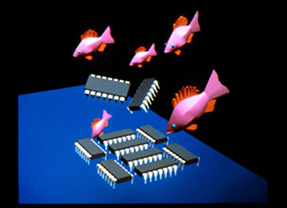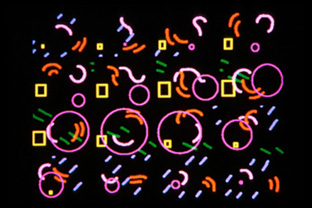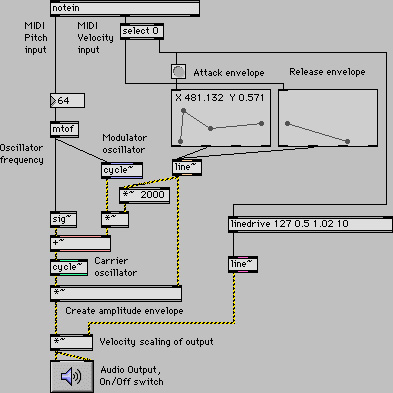

In 1971, on my first day of architecture
school, a professor said, "architecture is frozen music." I immediately
imagined liquid architecture and wondered how this might be realized. I had
studied the violin, photography, film, and video, and then began working with
multi-media installations as a way of freeing space and moving it in time. I
wanted to perform space and images the way a musician performs a musical instrument.I
had played the violin and moved from classical music to latin jazz, partly because
of the music itself, but also because of the social aspect of the oral traditions
informing it. I wanted to improvise moving images and spaces along with the
music. I imagined that all physical surfaces could be 3-dimensional screens,
semi-permeable membranes passing messages between interior spaces of the mind
and exterior spaces of the physical world, and between people communicating
in it.
In 1972, I traveled to Morocco from Denmark along with some friends of mine
who were expatriate American jazz musicians and poets. I was born in Denmark,
but spent 13 years in the United States, and as a result, I felt neither truly
at home in the United States nor in Denmark. I felt as though I too, was an
expatriate, only from 2 cultures. We had all moved a great deal in our lives,
and especially felt alienated from the Vietnam War which had become increasingly
brutal. It was a time of re-evaluation of our values and we rejected those that
would cause innocent people to suffer. We were misfits and as a result, nomads,
people with no fixed homes. We felt connected to the nomads of all cultures,
including those in Morocco, and considered the earth our real home and all people
our family.
I wanted to experience the architecture of the world and the living cultures
that shaped it with such rich histories and traditions. I wanted to explore
that which I did not know, challenge stereotypes, and form a more healthy relationship
to the world.
In Morocco, I had many wonderful experiences, but I want to tell you about a
specific one today. One of my fellow nomads was the poet and jazz musician Ted
Joans. Sometimes he would be inspired by something "in the air" or
something said or seen, and he would take out his trumpet and spontaneously
begin playing, right in the middle of an old town or medina.


Within what seemed like seconds, many people of all ages appeared from doorways
and around corners with small clay drums, and they would all play together,
filling the air with joy and energy. It filled our souls with the beauty of
the human spirit transformed into sound. Even though we came from different
cultures, we could transcend our differences when we played music together.
I thought to myself, if only we could do this with images and spaces, responding
to our physical and emotional gestures, too. If only we could use telecommunications
technology to bring together people from all over the world, along with their
rich cultural traditions, both visual and musical, and bring into being a global
visual music jam session.
With electronic cameras and imaging devices, microphones and electronic musical
instruments, it had become possible for the first time in history to perform
moving images as well as music in real-time. With digital technology, it would
also be possible to create and transform 3-D spaces in real-time, and share
memory and intelligence of organized information contained within it. With telecommunications
technology, it was possible to connect people all over the world with each other
and through these images, spaces and sounds, they would be able to play together.
This technology would be an instrument, not just a tool, affirming life rather
than destroying it. This was all possible, but it would take many years to realize,
especially considering the cost of technology and the poverty of so many around
the world. But even in Morocco, in many poor neighborhoods, I saw a great many
television antennas on top of houses. I felt it was imperative to democratize
new technology even more, and make it more inclusive of many cultures and traditions.
Music and visual arts and crafts were already close to the people, and so I
felt that the best way to create a dynamic, inclusive link between people and
technology was to work with those artforms in the context of new technology.
I began working towards this goal, step by step, beginning in 1972.
I began by exploring my own cultures
and subjective reality. If it was to be really inclusive of everyone's culture
and imagination, it had also to be inclusive of my own. I needed to find out
who I was, as a human being and a woman, first.


For the next 10 years, I worked in film and video, especially real-time video
synthesizers. By combining objective, photographic images, with subjective synthetic
images, I could begin to express emotional and intellectual states, informed
by dream and memory, and inspired by music.
I wanted to create a fluid continuum between interior and exterior, and between
sound and image. I worked with electronic music synthesizers, sensing and recording
devices, and linked them together using the patch programmable paradigms that
evolved from the early audio synthesizers designed by Robert Moog and Donald
Buchla. In those days we used oscilloscopes to produce raw dynamic visual images
from sounds. We also experimented with using electronic signals from video,
frequency shifted, as an audio source. But interesting sounds rarely produced
interesting images, and vice versa.
I came to use separately composed control signals to shape the generation of
both images and sounds. They could each be carefully considered and tuned independently,
while still sharing a fundamental, gestural link.

I also worked with early computer graphics systems in the mid seventies, but their limitations made them too problematic to use in real-time performance. Nonetheless, I continued to work with digital technology, and by the early 1980's I began teaching computer graphics to artists, and creating a series of stereoscopic computer generated images dealing with language, perception, and technology including this work, "Fish and Chips." (shown here in 2-D)

I continued to create installations and films that explored aspects of visual-music, which I consider poetry because it is associative, as well as my own cultural heritage. I pursued the integration of film, video, and 2 and 3-D computer graphics. My works during this time included Solstice, a series of multi-media works which explored an ancient pagan summer solstice ritual in contemporary Scandinavia, Concurrents and NLoops, multi-monitor computer-video installation and performance exploring visual relationships to polyrhythmic musical structures.


Between 1989 and 1993, I collaborated with computer scientist Phil Mercurio
at the San Diego Supercomputer Center to create a real-time stereoscopic animation
system.My stereoscopic work "Maya," also structured musically, is
inspired by the Hindu term for the conflict between illusion and reality. In
both NLoops and Maya, I collaborated with composer Rand Steiger. (These are
2-D stills, below, are from the stereoscopic animation, which is 7 1/2 minutes
long.)




Ten years ago, I heard about software called "Max" that was part programming
language and part application, which was starting to be used widely in the computer
music community. Max transferred the patch programmable paradigm of electronic
musical devices to the computer for the generation of real-time music. It allowed
musicians to create their own applications quickly and intuitively, without
the limitations of software applications, or the time consuming complications
of programming languages.

I thought to myself, if only this could be extended to images and collaborative spaces. A few years later, I met Miller Puckette, the author of "Max." I asked him, "can you do this with images, too?" He said yes, he and others were already working on it. Max had been extended to include some limited graphics capabilities. But more exciting than this, he was embarking on the creation of a new package that would build on the strengths of Max, but would go further. "Pd", or "Pure Data", would consider all data the same, regardless of origin. Once transferred into the computer, data from any modality would be available for interaction and even transformation into any other.
Soon afterwards, Mark Danks, a student from Princeton came to study with Miller
and Rand, who were by then teaching at UC San Diego, and he began making GEM,
Graphics Environment for Multimedia, that would bring the full capabilities
of Open GL graphics into the Pd environment (example below). Shortly thereafter,
Dana Plautz visited me at USC, and she invited me to apply to the Intel research
Council.
I thought about the
approach I had developed in my old synthesizer days, when I used common control
voltages to link video images and electronic sounds. I thought that the same
approach could be used to link moving images and sounds separated by great distances.
One could send movement and gesture information between 2 (or more) computer
systems which would then use these signals to animate the locally stored images
and sounds. This would eliminate the need to send entire animation and sound
databases in real-time, which is a very slow process on most of our currently
available networks. In fact, control voltages linking separate audio and video
systems are a good metaphor for what can be sent over a network for linking
computers at separate sites.
In addition, this approach would allow for each site to make additions or modifications
to the animation and music by mixing in site specific data, with the potential
to customize it in real time with input from local performers. The multiple
sites could interact with each other, but each would also be free to create
their own local performance by mixing in any data in whatever way was wished.
Miller, Rand, and I then had detailed discussions about these and related issues,
and prepared a full proposal. We are very grateful that Intel chose to support
our project.In our work, we would have to address several big issues. The first
was to describe what a flexible real-time digital visual-musical or poetic multi-modal
system would do. We would have to further develop the software that Miller and
Mark had begun, and set up hardware systems to fully realize the potential of
the software. Then we would have to consider the questions of networking, and
develop a strategy to cope with network latency. Finally, we would have to test
out our system in a real-time setting with live musicians and artists, and eventually
stage simultaneous, linked performances in 2, and then an increasing number
of separate sites.
We are, of course, aware of the many experiments by others in the area of performance
and telecommunications. The technical paradigm we have adopted reaches for a
higher level of abstraction in the communications protocol, and a greater degree
of fluidity between modalities. But we share with many artists the desire to
enrich present and future telecommunications systems with the tools necessary
to make long distance artistic collaboration possible.
Pd and GEM allow us to integrate 2 and 3D computer graphics and animation, video,
video synthesis and image processing, audio synthesis and signal processing,
and networking, thereby converging electronic technology of preceding decades.
We are working on how to integrate the elements and parameters of these previously
disparate media, one step at a time. We are working to integrate tools which,
for example, sense physical and musical gestures, as well as analyzing sounds
and moving images.
While we have many tools for synthesizing multiple 2 and 3-D images and objects
in GEM, including colorizing, texture mapping and texture animation, hierarchical
object animation and transformation, particle systems, lighting, keying and
layering, image analysis is in its beginning stages. We have focused primarily
on music and sound analysis so far, and the integration of live video and animating
textures from multiple sources. We are developing a neural net application as
well, as an additional way of making associations between data.
Miller has already created
objects for making network connections between computers running Pd, and we
are working on an object that will grab images from live webcams for real time
processing and display within GEM. The next stage in the area of web and networking
tools includes setting up Pd as a browser plug-in, with a specific application
that will function as a multi-media mixer that will allow users to mix and match
streaming audio and video from multiple sources on the internet. This way anyone
with a net connection can participate in our multiple site performances by making
their own mix of multi-media data coming in from the various sites involved.
Gradually, we hope to break down the distinction between broadcaster and receiver,
performer and audience, by having the full set of multi-media tools available
to all participants to both receive and send data, so that we can truly bring
about a global visual music jam session.

The bottom line is that the system be open and flexible, work in real-time,
and be freely and widely available. The reason for this is that the visual-musical
or other associations possible between modalities, are highly subjective and
vary widely. Rather than providing a fixed set of tools that assume universal
associative principles, we wish to provide the greatest flexibility possible
to allow for a wide variety of unique individual and cultural identities to
be shared in a global context.
We want to explore in greater depth the possibilities for creating subjective
relationships between modalities. We are interested in relationships such as
those that form the basis of "poetic" or associative thinking. Poetry
is visual-music and visual music is poetry, because it is associative. As the
late philosopher Alan Watts has stated, "The power of poetry comes from
its associative rather than logical qualities."
It is the richness of the associations and the fluid possibilities for further
interaction and association between multiple participants, that fascinates us.
This kind of poetic thinking is proliferating already as people engage it daily
through linked media on the world wide web. Because so many of our sense perceptions,
ideas and memories can flow fluidly across the digital continuum and continually
transform themselves non-linearly in real-time, what we are experiencing is
a kind of poetic collective consciousness, a kind of a shared lucid dream.
Our vision of networked,
improvised, multi-modal visual music, or liquid architecture or dynamic poetry,
is just one way of talking about a globally shared, lucid dream. Above all,
it is this dream of dreaming in the spaces that we share, that drives and informs
our research. While we are not yet there, we can see it clearly on the horizon.
Text and images
(c) 1998 Vibeke Sorensen